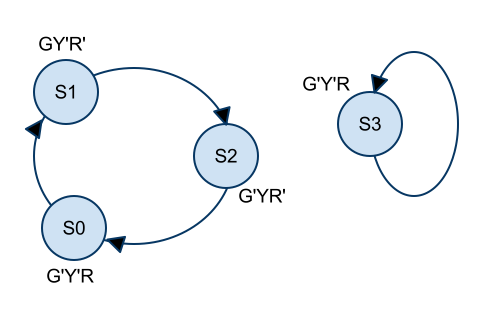CSC270 Lab 7 2011
--D. Thiebaut 17:10, 6 March 2011 (EST)
GYR Sequencer
Implement a traffic-light sequencer which activates 3 LEDs, one Green, one Yellow, and one Red, according to the state diagram shown below:

Go through the whole process, addressing each design stage:
- Timing diagram
- State diagram
- State transition table
- Finding the # of D-flipflops
- Assigning flipflop outputs (Qi) to States. But tonight, do not make Q1 equal to Green! :-)
- State transition table showing the Q outputs at Time n and Time n+1
- Add the outputs to the previous table
- Generate the boolean equations for the D inputs, and for the outputs (G, Y, R). Note, if you find that the G, Y and R signals will require too many different gates, and thus a large number of different circuits on your breadboard area, look into using the 74LS42 decoder instead. Using it would require just 2 chips to generate G, Y, and R! (Think of why this is.)
- Check that your equations are correct by simulating your sequencer with a Python program. You may use the program below for inspiration:
# GYRSequencer.py
# D. Thiebaut
# A very quick and dirty way to check a sequencer...
# This sequencer activates a G, Y, and R light system
# s.t. G is on for 2 cycles, followed by Y for 1 cycle
# followed by R for 1 cycle. Then the whole cycle repeats
Q1 = 0
Q2 = 0
for step in range( 20 ):
# the Q1 and Q2 outputs go through combinational logic to generate the new values
# of D1, D2, and the outputs G, Y, R...
D1 = Q1 ^ Q2
D2 = not Q2
G = Q1
Y = not ( Q1 or Q2 )
R = not ( G or Y )
# show the stable circuit signals
print "Q1Q2 = %d %d | GYR = %d %d %d" % ( Q1, Q2, G, Y, R )
# wait for the next clock tick (the user presses Enter)
raw_input( "> " )
# as soon as the clock has ticked, D1 and D2 get latched in the flipflops
# and Q1 and Q2 reflect the values captured.
Q1 = D1
Q2 = D2
- Once you have verified that your boolean equations are valid, wire up the circuit, connect the clock inputs to the 1Hz clock signal, and the G, Y, and R signals to LED, and demonstrate that your circuit works.